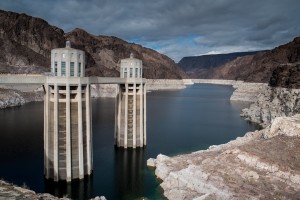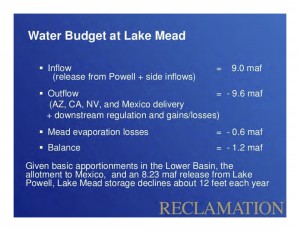No Lower Colorado River shortage for now, but don’t break out the party hats.
Lake Mead is forecast to end calendar year 2015 with a surface elevation of 1,082.33 feet above sea level, according to new numbers released yesterday by the U.S. Bureau of Reclamation. The current forecast for the end of 2016 is 1,079.57. The good news is that both of those numbers are greater than 1,075, which means the odds are against there being a “shortage” declared this year or next (when Mead hits 1,075 on some future January 1, rules kick in that reduce Arizona, Nevada, and Mexico allocations – repeat after me “this is not a crisis” – more here).
The bad news is that 1,079.57 is lower than 1,082.33, which means that even in these sorta good times, hydrologically speaking, Lake Mead keeps dropping. By “good times”, I mean that a big boost of precipitation in recent months in the Upper Colorado River Basin means that Lake Powell, the big reservoir at the upstream end of the Grand Canyon, is actually inching up right now. It’s forecast to end this year nearly five feet above last year’s levels, with the chance it could go up again next year. The good hydrology means that, under the river’s operating rules, Lake Powell will release “bonus” water this year and next. Under the rules, the Upper Basin is sorta legally required to release 8.23 million acre feet from Lake Powell down through the Grand Canyon to Lake Mead. This year and next, the current forecast calls for 9 million acre feet.
But despite that “bonus water”, the Bureau of Reclamation’s latest monthly water management planning report (the “24-month study”, pdf) shows Lake Mead is likely to just keep dropping.
How could that be?
The Lower Colorado “structural deficit”
Water managers call it the “structural deficit” – the hydrologic reality that under the current water allocation rules, there is more water allocated on paper flowing out of Lake Mead than can reliably be expected to flow into Lake Mead. The table describes what happens if Mead gets the legal minimum required, 8.23 million acre feet. With those levels of inflow, the “structural deficit” is 1.2 million acre feet per year. With the “bonus water” of a 9 million acre foot inflow from Lake Powell, the structural deficit shrinks to a few hundred thousand acre feet, give or take some math.
So to reiterate, even with a dollop of extra water flowing in, Lake Mead keeps dropping, as it will continue to do until the water management community comes up with a scheme to reduce allocations and consumption below current levels. As I said above, this is not a crisis. But neither is it a good thing.
I know, I know, y’all are working on it. I’ll quit nagging.



“Structural” makes it seem like it is out of our hands, out of our control. But it is entirely IN our hands. When will we adapt the rules to the new normal?
It’s not a crisis, okay, but it’s not a good thing either (that, despite bonus water this year, Lake Mead’s water level will continue dropping). John, IMO, you’re one of the most optimistic fellas I know, but if as you say, the news is not so great, do I sniff just a bit of, if not pessimism, resignation? Would GCI’s “Fill Mead first” be a worthwhile endeavor?
Peter –
I’m agnostic about the specific solution – “Fill Mead First”, or change the Lower Basin accounting for evaporation loss and Mexico deliveries, or some sort of general reduction in everyone’s allocation, or some sort of water banking scheme, etc. etc. There are lots of different approaches that might make the checkbook balance. The problem is that it needs to emerge from their process. So this is really about the incentives of the decentralized committee driving the bus – when risks rise to the point that they’ll do something.
I’m optimistic I guess because a) risks will eventually rise to that point, and b) the tools exist to reduce water use all across the Lower Basin system once they decide on the necessary rule changes.
John,
Lake Powell is not inching up that i can tell… it’s been steadily going down for about the past month.
SB – Sorry, I wasn’t clear there. I’m referring to year-over-year elevations. It’s four feet higher than last year at this time, and the 24-month study calls for it finish the year five feet above last year.
thanks John, sorry to be so nitpicky, i should just let it go on a blog right? 🙂
as for the water level, i sure hope it does end up much higher for everyone’s sake out there… the short term has been good for the west in many areas. i think everyone in California is hoping that El Nino will bail them out this winter and next spring…
Pingback: Water: Lake Powell April-July inflow about 94 percent of average | Summit County Citizens Voice